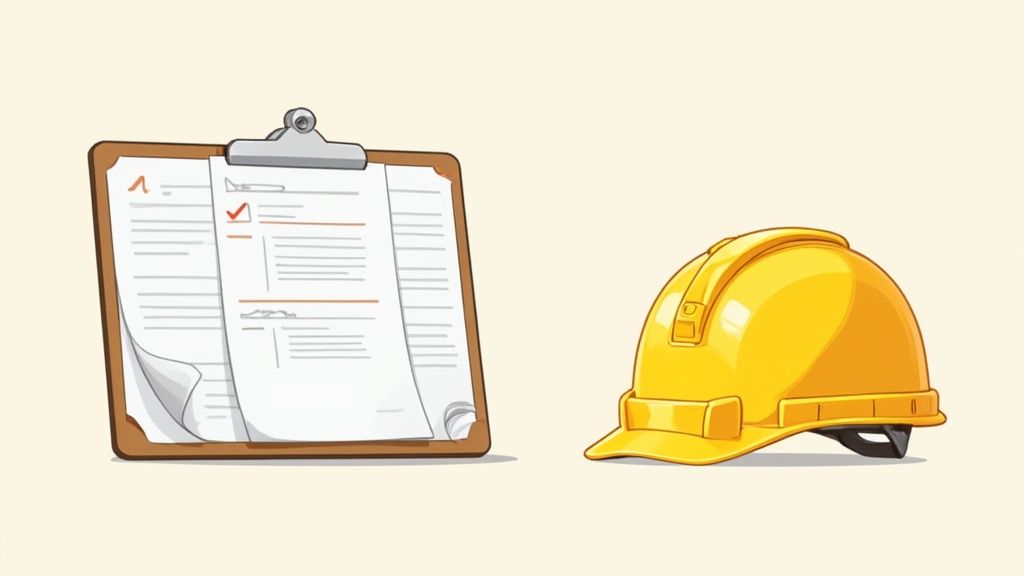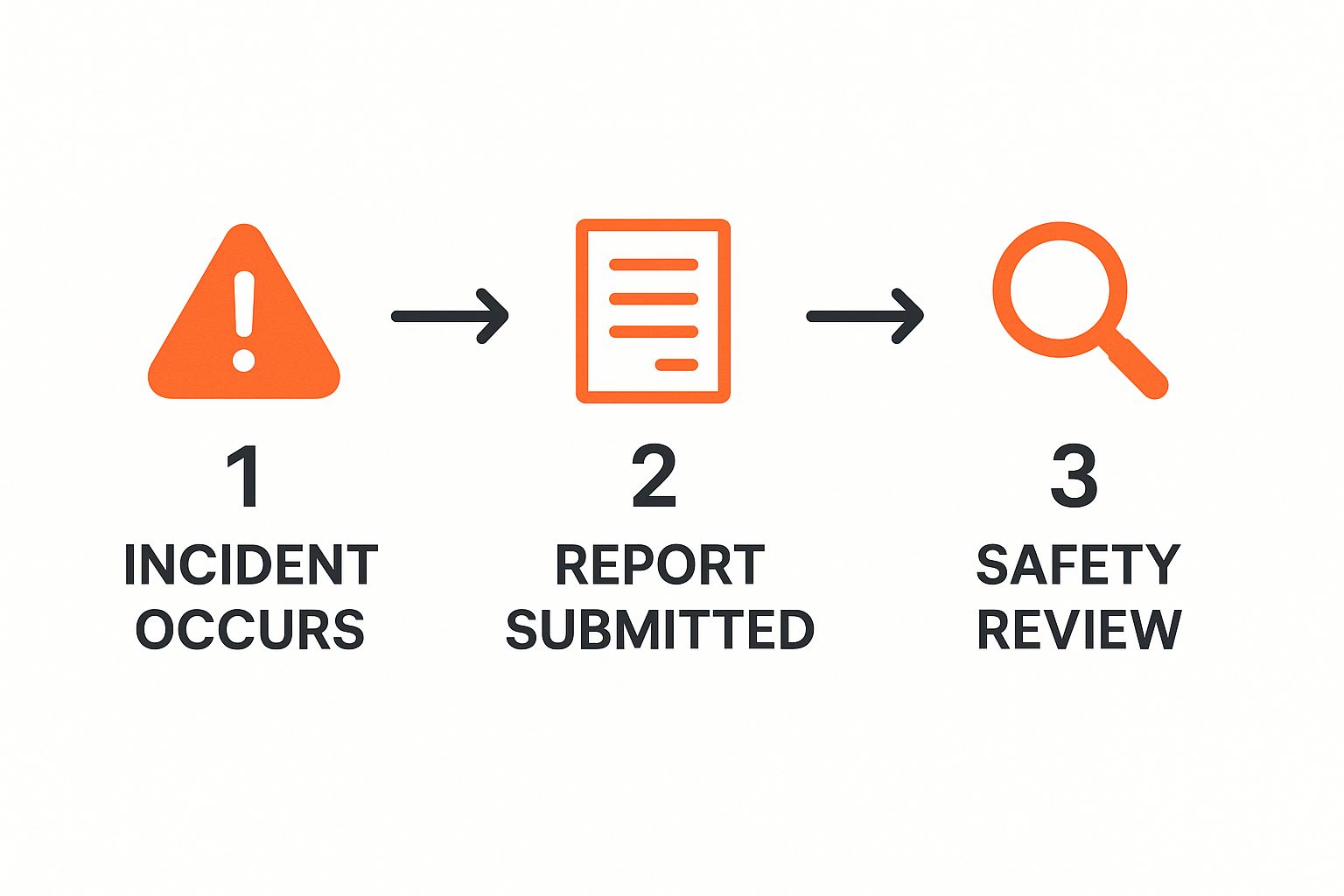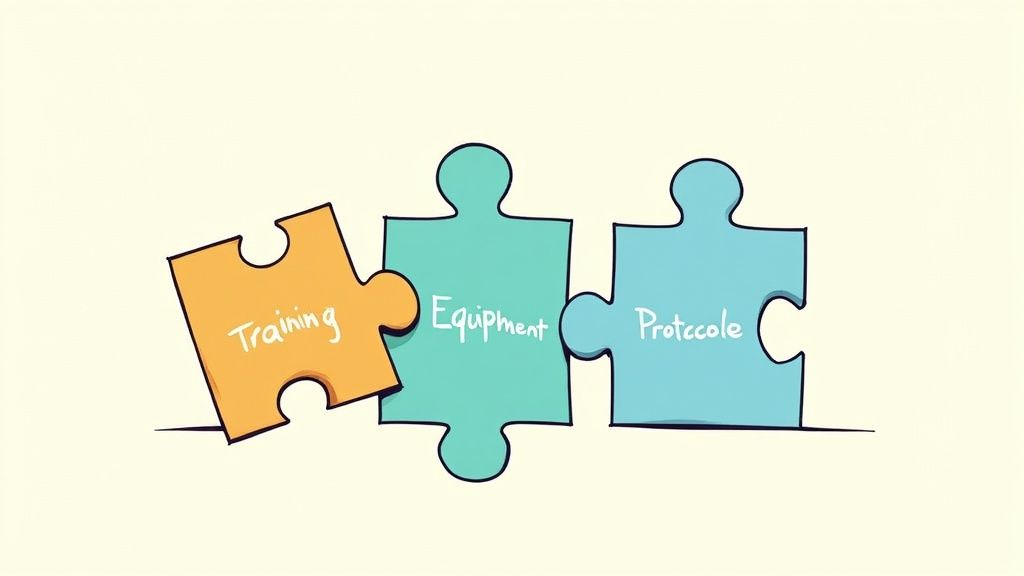A workplace incident report is your go-to document for capturing the immediate, factual details of an event. Think of it as a quick snapshot, not a deep-dive investigation. Its purpose is to get the key information down right away so you can take fast corrective actions, make the area safe, and meet your compliance duties.
Why a Quick Incident Report Matters

An incident report is the first alert. Its main job is to communicate what happened, quickly and clearly, so immediate action can be taken. This isn't the time to figure out the ultimate cause or point fingers; that comes later, if at all. The priority is getting the essential facts on paper while they’re still fresh in everyone's mind.
This speed is critical for a couple of big reasons. First, it gives managers and safety personnel the information they need to assess the situation and secure the area for everyone else. Second, it documents the event for compliance, which is a legal must-have for certain types of incidents. For instance, since January 2015, employers have been required to report any work-related severe injury to authorities within 24 hours.
Capturing the Facts, Not the Full Story
It’s crucial to remember that an incident report and an investigation are two completely different things. A report simply answers the basic questions:
- Who was involved?
- What happened?
- When and where did it occur?
- What immediate actions were taken (like first aid)?
An investigation, on the other hand, is a detailed analysis designed to find root causes. It often requires specialist knowledge and specific techniques to uncover why the incident happened and how to stop it from happening again. Your report is the starting point for that process, not the final word.
A good incident report provides the raw data. It's a collection of objective facts that creates a clear, unbiased picture of the event. The goal is to inform, not to interpret.
A Real-World Scenario in a Warehouse
Let’s walk through a common scenario: a near-miss in a busy warehouse. A forklift operator swings around a blind corner a bit too fast and has to slam on the brakes to avoid hitting a team member crossing the aisle. No one gets hurt, nothing gets damaged. It’s tempting to just write it off as a close call and get back to work.
But what happens if that worker fills out a simple workplace incident report?
The report would state the time, the exact location (Aisle 7, intersection B), the names of those involved, and a factual description: "Forklift turned corner and stopped abruptly to avoid pedestrian." That’s it.
This simple act of reporting provides incredibly valuable data. When the warehouse manager reviews it, they see a clear hazard. They don't need a full-blown investigation to start taking immediate corrective action.
From Report to Action
Based on the facts in that one report, the manager can roll out quick, practical solutions. These aren't complex, expensive changes; they are direct responses to the information provided.
Possible immediate actions could include:
- Installing a convex mirror at the blind corner to improve visibility.
- Repainting the pedestrian walkway lines to make them more obvious.
- Holding a short toolbox talk with all forklift operators to remind them of speed limits at intersections.
These are fast, simple fixes that make the workplace safer right away. Without that initial, quick report, the hazard would have gone unaddressed. The next person walking around that corner might not have been so lucky. An incident report turns a near-miss into a learning opportunity, preventing a future accident before it has a chance to happen.
Reporting Is Not the Same as Investigating
Filling out an incident report isn't the same as running a full-scale investigation. They are two very different things, and knowing the difference is key.
An incident report is the first, vital step. It’s about getting the key information down quickly so immediate corrective actions can take place, the workplace can be made safe, and compliance actions can be done. Think of it as a quick snapshot focused on the who, what, when, and where.
An incident investigation, in contrast, is an in-depth process that requires specialist knowledge and techniques like ICAM or Bowtie analysis to find root causes and long-term solutions.
This is the basic flow: an incident happens, a report is filed, and then a safety review decides what to do next.

As you can see, your report is what kicks off the entire safety response. It's the starting gun, not the finish line.
So, What's the Report's Job?
The main purpose of a workplace incident report is to create a formal, factual record of what happened. It’s an information-gathering tool, plain and simple. Its power lies in being immediate and objective.
Let's imagine a scenario. A metal bracket falls from a high shelf in a warehouse, landing just centimetres from a worker. The incident report needs to capture:
- The date and time it happened.
- The precise location (e.g., Bay 3, Rack C).
- The name of the worker who was nearly hit.
- A simple description: "A 1kg metal bracket fell from the top shelf, landing on the floor."
- Immediate action taken: "The area was cordoned off with safety tape."
That’s it. This report gives a supervisor everything they need to act fast. They can secure the area and check other shelves for similar risks without needing to know why the bracket fell.
Your job is to get the facts down on paper. Think of yourself as the witness providing the initial statement, not the detective brought in to solve the case.
What an Investigation Tries to Achieve
An incident investigation is a separate, specialized process. If the first report points to a serious or recurring problem, an investigation team might be assembled. Their mission is to go way beyond the initial facts.
These teams use specific methods to uncover what’s really going on under the surface. This could involve:
- Interviewing witnesses in far more detail.
- Reviewing maintenance logs and old procedures.
- Analyzing equipment performance and design flaws.
- Using techniques like the Incident Cause Analysis Method (ICAM) or Bowtie analysis to map out every contributing factor.
These methods are designed to expose systemic weaknesses, not just the obvious trigger. An investigation into our falling bracket might uncover that the shelving unit was overloaded, there was no procedure for securing loose items, or that vibrations from nearby machinery were slowly shaking things loose. Those are the root causes a simple report is not designed to find.
Incident Report vs Incident Investigation
To make it crystal clear, let's look at a side-by-side comparison. Understanding this helps you focus only on what’s needed when you're writing that initial report.
| Aspect | Workplace Incident Report | Incident Investigation |
|---|---|---|
| Purpose | To record the immediate facts of an event quickly and accurately. | To identify root causes and systemic failures to prevent recurrence. |
| Timing | Immediate. Should be completed as soon as possible after the incident, ideally within 24 hours. | Follow-up process. Can take days or weeks, depending on complexity. |
| Focus | Answers "Who, What, When, Where." | Answers "Why" and "How." |
| Level of Detail | A concise summary of factual information. | An in-depth analysis of all contributing factors. |
| Responsibility | Usually completed by the employee involved, a witness, or a direct supervisor. | Conducted by a dedicated team, often with specialized safety knowledge. |
| Outcome | Triggers immediate corrective actions, ensures compliance, and informs the decision to investigate. | Results in long-term corrective actions, changes to procedures, and systemic improvements. |
Your role in writing a workplace incident report is vital. You’re providing the clean, unbiased data that the entire safety process is built on. By sticking to the facts and leaving the analysis to the investigators, you create a document that is practical, useful, and drives the immediate action needed to keep everyone safe.
What to Include in Your Incident Report

When something goes wrong on-site, the last thing anyone needs is a scramble to figure out what information to collect. A solid workplace incident report isn't about writing a novel; it’s about capturing the essential facts, quickly and clearly.
Your real goal here is to create a straightforward record that gives your safety team what they need for immediate action and long-term prevention. Sticking to a consistent format means you won’t miss anything crucial in the heat of the moment, which is when details are easiest to forget.
The Foundational Details
Every single report needs to start with the basics. These details anchor the entire event, providing the context and timeline. Without them, the rest of the information is practically meaningless.
Think of these as the "who, what, when, where" of your report:
- Date and Time of the Incident: Be precise. We need to know when the event happened, not just when the form was filled out.
- Specific Location: "Warehouse floor" isn't good enough. Get specific. "Aisle 4, next to the pallet racking" or "at the CNC machine, station 2" helps pinpoint exactly where the hazard exists.
- Date and Time the Report was Filed: This little detail helps track how quickly incidents are being logged after they occur.
- Name of the Person Reporting: This is for accountability and makes it easy to follow up with any clarifying questions later on.
Getting these simple facts right is the first step toward a useful document.
Information About People Involved
Next, you need a clear list of everyone directly involved. This isn't about assigning blame. It’s about creating a factual record of who was present and what role they played.
Break it down into simple categories:
- Injured Person(s): If someone was hurt, get their full name, job title, and department. This is non-negotiable for first aid, medical follow-up, and any potential workers' compensation claims.
- Witnesses: Jot down the full names and contact details of anyone who saw what happened. Their firsthand accounts are invaluable if a more detailed review is needed.
- Others Involved: Was another equipment operator part of the incident, but not injured or a direct witness? Note their details, too.
Keep this section purely factual. It's just a list of names and roles. Avoid any language that even hints at fault or responsibility.
It's also worth noting the broader trends. According to the Australian Bureau of Statistics, 6.3% of workers left jobs due to their own ill health or injury in 2025. This is a noticeable increase and highlights why accurately recording who was involved is so important for spotting wider workplace health issues. You can dig into the latest ABS data to see more on this.
The Objective Description of the Incident
This is the heart of your report. Your job is to describe exactly what happened using objective, fact-based language. Now is not the time for guesswork, opinions, or emotional descriptions. Stick to what you saw and heard.
Imagine you're a security camera recording the scene. Just state the facts in a clear, chronological order.
Manufacturing Example: A Minor Burn
Let's say a worker, Sarah, gets a minor burn from a piece of machinery.
- Vague and unhelpful (what to avoid): "Sarah was being careless and wasn't paying attention, so she burned her arm on the hot machine."
- Factual and objective (the right way): "At 10:15 AM, Sarah was operating the heat-sealing machine. As she reached to clear a jam, her right forearm made contact with the machine's unguarded heating element. She immediately pulled her arm away."
See the difference? The second description is powerful. It outlines the sequence of events without judgment and clearly identifies a potential hazard—the "unguarded heating element." That gives us a direct, physical problem to solve.
Detailing Injuries and Damage
If the incident caused any harm to a person or damage to property, you need to document it with specifics. Again, stick to what you can actually observe.
For injuries, describe what you can see:
- What was injured? (e.g., left hand, right ankle)
- What does the injury look like? (e.g., a 2cm cut, redness and swelling, a small blister)
- What first aid was given? (e.g., "The wound was cleaned, and a bandage was applied by the site's first aid officer, Tom.")
Be just as specific for property damage:
- What was damaged? (e.g., the forklift's safety light, a pallet of stock)
- What is the extent of the damage? (e.g., "The safety light's plastic cover is cracked," "Two boxes on the pallet were crushed.")
This information is crucial for everything from medical treatment and insurance claims to getting repairs underway. Your company's approach to recording these details should tie directly back to your overarching safety policies. If you're looking to build or refine those, a workplace safety policy template can be a great place to start.
Immediate Actions Taken
Finally, your report must detail what was done right after the incident to make the situation safe. This shows you’re on top of things and have responded quickly to control any ongoing hazards.
List the immediate steps taken. For our burn example with Sarah, that might look like this:
- The machine was immediately shut down and locked out by the supervisor.
- Sarah was escorted to the first aid station for treatment.
- A temporary barrier was placed around the machine with a "Do Not Operate" sign.
This section closes the loop on the initial response. It confirms the immediate risk has been managed, paving the way for a more thoughtful investigation into what happens next. It's the final, critical piece of an effective incident report.
Common Reporting Mistakes to Avoid
Knowing what to put in a workplace incident report is only half the battle. Just as crucial is knowing what to leave out. Many reports become less useful, create confusion, or even introduce liability simply because of a few common mistakes.
Avoiding these simple traps is one of the easiest ways to improve the quality of your reporting. It’s not about being a perfect writer; it’s about sticking to a practical, fact-based approach every single time.
Adding Opinions and Assumptions
This is probably the most common and damaging mistake you can make. An incident report is a place for facts only. As soon as you start adding your personal opinions, assumptions, or guesses about what happened, you undermine the document's credibility.
Statements like "he was rushing" or "she seemed distracted" are subjective. They can’t be proven and immediately shift the focus from the physical hazards to someone’s state of mind, which is a dead end for any real investigation.
- Before: "John was careless and wasn't watching where he was going, so he tripped over the pallet."
- After: "John was walking through Aisle 3. A wooden pallet was on the floor in the designated walkway. His left foot caught the edge of the pallet, and he fell forward."
The second version is pure fact. It identifies a clear hazard—a pallet in a walkway—without any personal judgment.
Assigning Blame
A workplace incident report is not the place to point fingers. Its purpose is to record an event so that immediate corrective actions can take place. Assigning blame to an individual shuts down the opportunity to find and fix the real, underlying causes.
Blame creates a defensive atmosphere and discourages people from reporting incidents in the future. The focus should always be on the "what," not the "who."
The moment a report tries to establish fault, it stops being a safety tool and starts becoming a disciplinary one. Stick to describing the actions and conditions, and let the follow-up process determine the causes.
For example, instead of writing, "It was Mark's fault for not putting the guard back on," state the objective facts. "The machine was being operated by Mark. The safety guard was found on the floor next to the machine at the time of the incident."
Using Vague and Unhelpful Language
Details matter, a lot. Vague descriptions like "the floor was messy" or "the equipment malfunctioned" don't give a safety manager anything to work with. What made the floor messy? How exactly did the equipment malfunction? Be as specific as you possibly can.
Precise language helps pinpoint the exact problem that needs to be fixed.
- Vague: The area was unsafe.
- Specific: There was a 30cm-wide puddle of oil on the concrete floor next to the hydraulic press.
This level of detail allows for a direct solution, such as identifying a leak in the press or improving cleanup procedures. The same goes for near misses. Understanding the exact details of a close call is essential for preventing a real incident. You can find more practical advice on this in our guide to the near miss report.
Delaying the Report
Time is of the essence. Memories fade, details get fuzzy, and physical evidence can be moved or cleaned up. Waiting too long to file a workplace incident report is a recipe for an inaccurate record.
The goal should be to complete the report as soon as safely possible, ideally within the same shift or at least within 24 hours. Prompt reporting ensures the information is fresh and allows for immediate action to secure the area and prevent a recurrence. A delay can turn a minor issue into a major problem simply because no one knew about it fast enough.
This speed is especially critical given the high stakes in many Australian industries. Data from Safe Work Australia shows that in 2023, there were 200 worker fatalities, with vehicle incidents and falls from height being major contributors. The most affected sectors were construction, transport, and manufacturing, which accounted for over three-quarters of these deaths.
These aren't just numbers; they represent why every single incident, no matter how small, needs to be reported promptly to address risks before they escalate. You can learn more about these key workplace safety statistics and what they mean for high-risk industries.
What Happens After You Submit a Report

Handing in your workplace incident report is a crucial first step, but it’s certainly not the end of the line. Understanding what happens next shows you exactly how your quick, factual account starts a chain of events that directly leads to a safer worksite. It's not just paperwork disappearing into a filing cabinet; it’s the catalyst for real action.
Once submitted, the report typically lands on the desk of a supervisor, manager, or a designated safety officer. Their first job is to review the information you’ve provided to get a clear picture of the situation and its immediate risks. This initial review is all about speed and triage.
The Immediate Response and Hazard Control
The absolute top priority after a report is filed is to control any immediate hazards. The information in your report is what guides this response. For example, if your report mentioned a spill of hydraulic fluid, the first action would be to cordon off the area and get it cleaned up. Simple.
This response is purely practical and focuses on making the area safe for everyone else. Immediate actions might include:
- Shutting down and locking out a piece of equipment.
- Placing temporary barriers or warning signs around a hazard.
- Providing further first aid or medical attention to anyone involved.
These quick fixes are a direct result of the clear, factual details you included in your report. They stop the problem from getting worse or affecting anyone else.
A good report triggers a fast response. The goal isn’t to find a long-term solution in the first five minutes but to stabilise the situation and prevent further harm.
Deciding on the Next Steps
After the immediate danger is managed, the reviewer assesses the severity and nature of the incident. This is a key decision point. Based on the facts in your report, they will determine if the situation requires a full, in-depth incident investigation.
Not every incident needs a massive investigation. A minor first-aid case might just be logged for tracking purposes, with a quick fix like restocking a first aid kit. However, a serious near-miss or an equipment failure will almost certainly trigger a much deeper look. Many companies use a risk matrix to make this decision consistently.
An effective incident management system helps to track these decisions, ensuring nothing falls through the cracks and providing a clear record of what actions were taken for each report.
Compliance and Regulatory Duties
Finally, your report serves a critical compliance function. For certain types of serious incidents, employers have a legal obligation to notify regulatory bodies like Safe Work Australia or their state equivalent. Since 2015, employers have had a legal duty to report any work-related severe injury within 24 hours.
Your workplace incident report is the primary document used to determine if an incident is notifiable. It provides the official record needed to meet these legal duties, protecting both the workers and the company. This formal process ensures that the right authorities are aware of serious events, contributing to broader industry safety analysis and prevention efforts.
Got Questions? We've Got Answers
Here are some quick, direct answers to the common questions we get about writing incident reports. These are the practical, real-world issues that often pop up but don't always fit neatly into a step-by-step guide.
How Soon Should I Write the Report After an Incident?
Get it done as soon as you can, ideally on the same shift or at least within 24 hours. The longer you wait, the fuzzier the details get.
Prompt reporting is about more than just good memory. It’s about immediate action. The sooner your team knows what happened, the faster they can secure the area and make sure no one else gets hurt.
What If I Don't Know All the Details?
That’s completely fine. In fact, it’s expected. The golden rule is simple: stick to what you know for sure. Never guess or add information you aren't certain about just to fill in a blank space.
If you don’t know something, just say so. For example, if you didn’t see the actual moment someone slipped, you can write, "the specific cause of the fall is unknown at this time." Your report is a factual record, not a detective novel. Sticking to what you personally saw and heard is always the right call.
A report with a few "unknowns" is a thousand times more useful than one filled with assumptions. The facts you provide are the foundation; investigators can fill in the missing pieces later if needed.
Should I Include the Names of Witnesses?
Yes, absolutely. Always list the names and contact details for anyone who saw what happened. Their accounts are gold.
Giving your supervisor or safety officer a list of witnesses makes their job infinitely easier if they need to follow up. Different perspectives can help build a complete, accurate picture of the event, which is crucial if a formal investigation kicks off.
What If the Incident Seems Minor?
Report it. You should report all incidents, even if they seem insignificant. That includes near misses, where nobody got hurt and nothing was damaged.
Why? Because today’s minor trip hazard or small equipment glitch could be tomorrow’s major injury waiting to happen.
Think of it this way: a near-miss report about a wobbly ladder is the best possible warning sign to get it fixed before someone takes a serious fall. Each report, big or small, is a piece of the puzzle that helps create a genuinely safer workplace.
Safety Space provides a single, simple platform to manage your incident reports, hazards, and all your other safety tasks. Ditch the paperwork and get the real-time oversight you need to protect your team and your business. Book a free demo today and see how it works.
Ready to Transform Your Safety Management?
Discover how Safety Space can help you build a safer, more compliant workplace with our comprehensive safety management platform.
Book a Free DemoRelated Topics
Safety Space Features
Explore all the AI-powered features that make Safety Space the complete workplace safety solution.
Articles & Resources
Explore our complete collection of workplace safety articles, tools, and resources.
